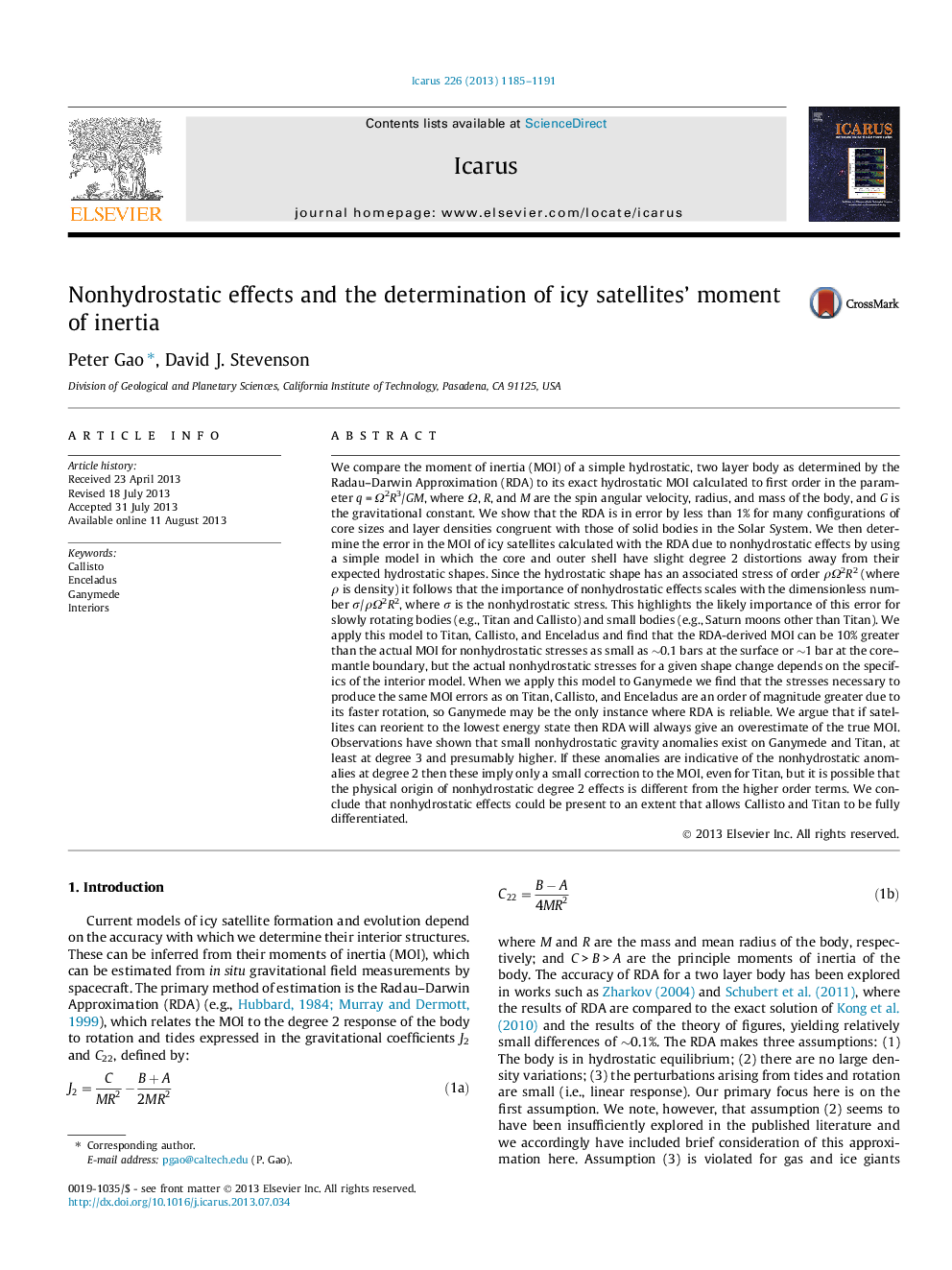| کد مقاله | کد نشریه | سال انتشار | مقاله انگلیسی | نسخه تمام متن |
|---|---|---|---|---|
| 10701374 | 1021129 | 2013 | 7 صفحه PDF | دانلود رایگان |
عنوان انگلیسی مقاله ISI
Nonhydrostatic effects and the determination of icy satellites' moment of inertia
ترجمه فارسی عنوان
اثرات غیر هیدرواستاتیک و تعیین ماهیت یخ های ماهواره ای از اینرسی
دانلود مقاله + سفارش ترجمه
دانلود مقاله ISI انگلیسی
رایگان برای ایرانیان
کلمات کلیدی
کالیستو، انسلادوس، گانیمید، فضای داخلی،
موضوعات مرتبط
مهندسی و علوم پایه
علوم زمین و سیارات
علوم فضا و نجوم
چکیده انگلیسی
We compare the moment of inertia (MOI) of a simple hydrostatic, two layer body as determined by the Radau-Darwin Approximation (RDA) to its exact hydrostatic MOI calculated to first order in the parameter q = Ω2R3/GM, where Ω, R, and M are the spin angular velocity, radius, and mass of the body, and G is the gravitational constant. We show that the RDA is in error by less than 1% for many configurations of core sizes and layer densities congruent with those of solid bodies in the Solar System. We then determine the error in the MOI of icy satellites calculated with the RDA due to nonhydrostatic effects by using a simple model in which the core and outer shell have slight degree 2 distortions away from their expected hydrostatic shapes. Since the hydrostatic shape has an associated stress of order ÏΩ2R2 (where Ï is density) it follows that the importance of nonhydrostatic effects scales with the dimensionless number Ï/ÏΩ2R2, where Ï is the nonhydrostatic stress. This highlights the likely importance of this error for slowly rotating bodies (e.g., Titan and Callisto) and small bodies (e.g., Saturn moons other than Titan). We apply this model to Titan, Callisto, and Enceladus and find that the RDA-derived MOI can be 10% greater than the actual MOI for nonhydrostatic stresses as small as â¼0.1 bars at the surface or â¼1 bar at the core-mantle boundary, but the actual nonhydrostatic stresses for a given shape change depends on the specifics of the interior model. When we apply this model to Ganymede we find that the stresses necessary to produce the same MOI errors as on Titan, Callisto, and Enceladus are an order of magnitude greater due to its faster rotation, so Ganymede may be the only instance where RDA is reliable. We argue that if satellites can reorient to the lowest energy state then RDA will always give an overestimate of the true MOI. Observations have shown that small nonhydrostatic gravity anomalies exist on Ganymede and Titan, at least at degree 3 and presumably higher. If these anomalies are indicative of the nonhydrostatic anomalies at degree 2 then these imply only a small correction to the MOI, even for Titan, but it is possible that the physical origin of nonhydrostatic degree 2 effects is different from the higher order terms. We conclude that nonhydrostatic effects could be present to an extent that allows Callisto and Titan to be fully differentiated.
ناشر
Database: Elsevier - ScienceDirect (ساینس دایرکت)
Journal: Icarus - Volume 226, Issue 2, NovemberâDecember 2013, Pages 1185-1191
Journal: Icarus - Volume 226, Issue 2, NovemberâDecember 2013, Pages 1185-1191
نویسندگان
Peter Gao, David J. Stevenson,
